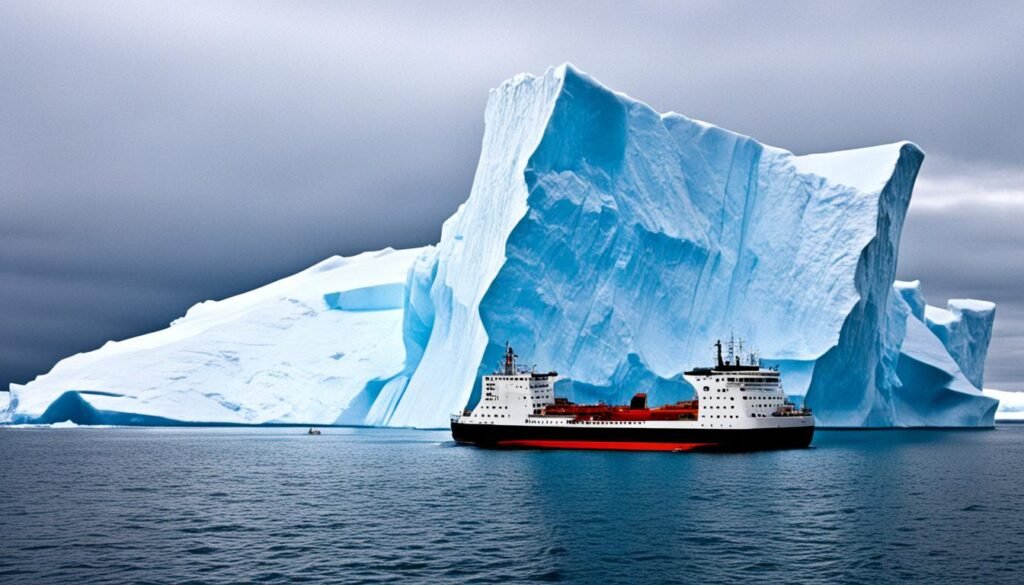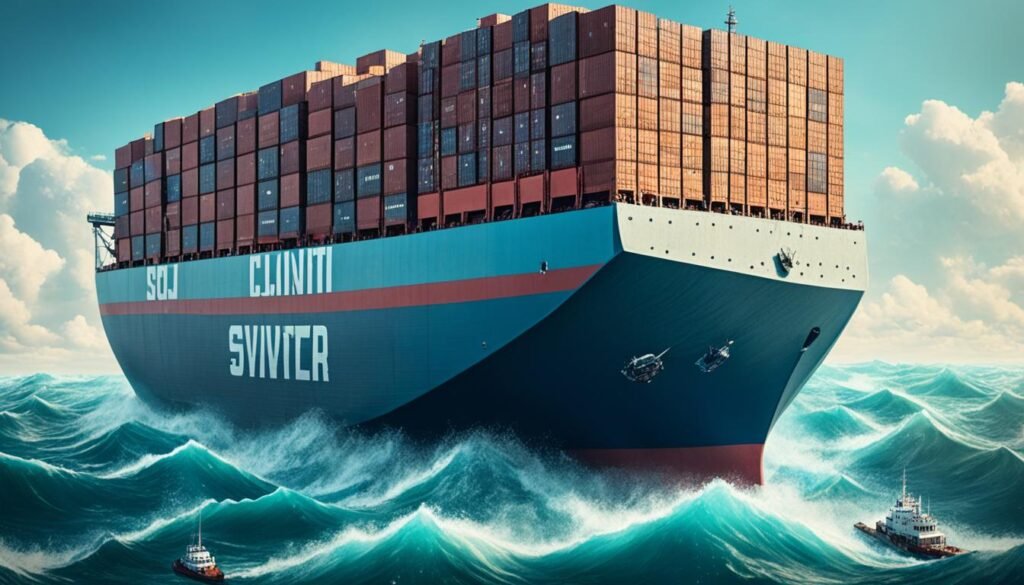Have you ever seen a huge cargo ship sail across the ocean, carrying thousands of tons of goods? Yet, a small steel nail would sink if you dropped it in the water. How does a massive ship stay afloat while a tiny nail sinks? The answer lies in buoyancy, density, and displacement, discovered by Archimedes.

When you put an object in water, it takes up space equal to its own volume. The water pushes back with a force that helps objects less dense than water float. This is why steel ships can float. They are less dense than water because of the air inside them.
Archimedes’ Principle: The Key to Buoyancy
Over 2,200 years ago, Archimedes, a Greek mathematician, found a key principle. He discovered why some objects float and others sink. This principle says that an object in a fluid feels an upward force equal to the weight of the fluid it displaces.
This force helps objects less dense than the fluid float. It’s like a magic force that makes things float.
Displacement and Buoyant Force
When an object goes into a fluid, it pushes aside some of that fluid. The weight of this pushed fluid creates a buoyant force. If this force is stronger than the object’s weight, it will float.
How dense an object is compared to the fluid matters a lot. If it’s less dense, it will float. If it’s denser, it will sink. Measuring an object’s weight loss in water can tell you if it will float or sink.
| Substance | Density (kg/m³) |
|---|---|
| Aluminum | 2,700 |
| Water | 1,000 |
| Air | 1.29 |
| Brass | 8,440 |
| Mercury | 13,600 |
Knowing about archimedes’ principle, buoyancy, water displacement, fluid dynamics, hydrostatics, and hydrodynamics is key. It helps design objects that can float and stay balanced.

Density and Flotation
How an object floats or sinks depends on its density compared to the density of water. If an object is less dense than water, it floats. But if it’s denser, it sinks. For example, cargo ships can float because they’re less dense than water, even with air inside them. On the other hand, small metal nails are denser and sink quickly.
The size of a boat also matters for floating. Bigger boats that weigh the same as smaller ones can float better because they displace more water. The density of an object is key to whether it floats or sinks, as shown by the steel nail sinking because it’s denser than water.
| Object | Density | Flotation |
|---|---|---|
| Steel Nail | Greater than water | Sinks |
| Ocean Liner | Less than water | Floats |
| Submarine | Almost equal to water | Adjusts density to sink or surface |
Whether an object floats or sinks depends on its density compared to the density of the water. Archimedes’ Principle explains this by saying the weight of water an object displaces equals the buoyant force it feels. This is why objects can float.

The air inside a ship also changes its density. A ship with more air will be less dense and float higher. But a ship full of cargo will be denser and float lower. Submarines can change their density by filling or emptying tanks to sink or surface.
Why Giant Cargo Ships Float While Tiny Nails Sink
Ship Design and Trapped Air
Giant cargo ships can float while tiny nails sink because of ship design and trapped air. These ships have big, hollow hulls that hold a lot of air inside. This air makes the ship less dense than the water around it.
This means the ship is lighter than the water it displaces. So, it floats because the water pushes it up as much as the ship weighs it down. On the other hand, small nails are dense and don’t have much air inside. They’re heavier than water and sink.
The design of the ship and the air pockets inside are key reasons why big steel ships can float. This lets them stay on top of the water.
| Object | Density Compared to Water | Ability to Float |
|---|---|---|
| Cargo Ship | Less Dense | Floats |
| Steel Nail | More Dense | Sinks |
The secret to this is in the ship design and using trapped air in the hull. By making ships hollow and air-filled, naval architects can make them lighter. This lets the ship stay afloat by displacing water.
The Role of Surface Area and Weight Distribution
The shape and surface area of an object are key to whether it floats or sinks. Objects with a big surface area compared to their weight, like cargo ships, feel more buoyant forces. These forces help them stay afloat. The distribution of weight across a ship’s hull is even, making it easier for the water to support the ship.
On the other hand, small nails have a tiny surface area for their mass. This means they don’t have enough buoyant force to fight their heavy weight. So, they sink. The way an object’s shape, surface area, and weight distribution work together is what decides if it will float in water.
For example, the air pressure on a small area can be as heavy as 225kg. This shows how surface area and pressure distribution can change if an object floats or sinks.
| Substance | Density (g/cm³) |
|---|---|
| Aluminum Foil | 2.7 |
| Copper | 8.8 |
| Gold | 19.32 |
| Iron/Steel | 7.8 |
| Lead | 11.3 |
| Tungsten | 19.30 |
| Blood | 1.05 |
| Sea Water | 1.025 |
| Ethyl Alcohol | 0.79 |
| Olive Oil | 0.92 |
| Petrol | 0.68 |
| Air | 1.29 x 10^-3 |
| Carbon Dioxide | 1.98 x 10^-3 |
| Helium | 0.18 x 10^-3 |
| Nitrogen | 1.25 x 10^-3 |
This table shows the densities of different substances. It’s important to know how surface area, weight distribution, and density work together. This knowledge helps in making objects that can float or sink in water.
Materials Science and Maritime Engineering
The reason why cargo ships float but tiny nails sink is due to materials science and maritime engineering. The materials used in shipbuilding, like steel, are key to their buoyancy.
Steel is a dense material but can be made into large, hollow structures. These structures trap air, making the ship lighter. Maritime engineers use this to design ships that float by displacing water.
The science behind this is complex. It involves fluid mechanics, naval architecture, and the properties of materials. This knowledge helps the shipbuilding industry make vessels that seem to defy their weight.
About 77% of the world’s merchant ships were made in Japan and Korea in 2000. Using alloys like aluminum can also save a lot of weight. This shows how vessel design is always improving.
The maritime industry is always changing. Materials science and engineering will become even more important. They will help make ships more efficient and advanced in the future.
Practical Applications and Demonstrations
Simple experiments can show us how buoyancy, density, and fluid displacement work. For example, the aluminum foil boat activity is a great way to learn. By making a boat shape from aluminum foil and testing its floatation with different weights, you see how an object’s density affects its buoyancy.
Aluminum Foil Boat Experiment
Start by molding a boat shape from aluminum foil. Make sure it has a flat bottom and sides to hold weight. Place it in water in a tub or container.
Then, add pennies or small objects to the boat, one by one. Watch as it sinks with each added weight. This shows how an object’s density affects its buoyancy.
The boat sinks as it gets heavier and its density goes up. This shows why big ships can float but small nails sink. It’s a clear demonstration of scientific principles.
| Experiment Details | Key Findings |
|---|---|
| Active Time: 45 minutes to 1 hour Total Project Time: 45 minutes to 1 hour Number of Science Fair Project Ideas: Over 1,200 Recommended Number of Pennies Used: Up to 200, depending on boat size and shape | Density of Water: 1 gram per cubic centimeter Weight of a Single Penny: 2.5 grams Range of densities of boat hulls: 0.7 to 1.3 grams per cubic centimeter Maximum weight boat hull could support before sinking: Determined by number of pennies added |
This experiment is a fun way to learn about density, buoyancy, and water displacement. By playing with the aluminum foil boat, you can understand how these forces affect objects in water. It helps you see why some objects float and others sink.
You can check out this blog post for more information How Do Large Ships Float?
Conclusion
Giant cargo ships can float on water, while tiny steel nails sink. This shows how buoyancy, density, and displacement work, as explained by Archimedes. The air inside the ship makes it lighter than the water it displaces.
Thanks to material properties and engineering, huge steel ships can defy gravity. We can see these principles at work through experiments. This helps us understand why big ships float and small nails sink.
Understanding density, displacement, and Archimedes’ principle helps us understand why ships float. These ideas are important in many areas, like materials science and ship design. By using these principles, we can make new and innovative solutions to our problems.
FAQ About Why Giant Cargo Ships Float While Tiny Nails Sink
What is the key principle that explains why giant cargo ships can float while tiny nails sink?
The key principle is Archimedes’ Principle. It says that an object in a fluid gets an upward buoyant force. This force is equal to the weight of the fluid it displaces.
How does the density of an object compared to the density of water determine whether it will float or sink?
An object’s density compared to water’s density decides if it will float or sink. If it’s less dense than water, it floats. But if it’s denser, it sinks.
What role do the design and structure of cargo ships play in their ability to float?
Cargo ships are made with big, hollow hulls that hold a lot of air. This air makes the ship less dense than the water it displaces. The buoyant force from the water helps counteract gravity, letting the ship float.
How do the shape, surface area, and weight distribution of an object affect its ability to float or sink?
Objects with a big surface area and less weight, like cargo ships, feel more buoyant forces. These forces help counter gravity. The ship’s weight is spread out over a large hull, making it easier for the water to support it.
What role do the materials used in ship construction play in their buoyancy?
The materials used in building ships, like steel, are important for buoyancy. Steel can be made into large, hollow structures. These trap air, making the ship less dense overall.
Other related posts
